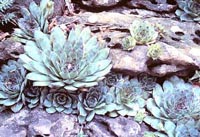Resource Library
Plant of the Week: Hens-and-Chickens
The University of Arkansas System Division of Agriculture does not promote, support or recommend plants featured in "Plant of the Week." Please consult your local Extension office for plants suitable for your region.
Plant of the Week
Hens-and-Chickens
Latin: Sempervivum tectorum

Since childhood rocks have fascinated me. From informal polls taken at various talks, I’m not alone in this infatuation because about half the people readily admit to purloining roadside rocks as they travel about our great nation.
Rock gardening is a gardening style where a natural affinity for rocks and plants intersect. Hens-and-Chickens (Sempervivum tectorum) is but one of the thousands of plants that can be grown in the rock garden.
Hens-and-chicks, a name soon to become obsolete as city dwellers loose the visual inference it implies, is a member of the Crassulaceae family - the same group to which sedum, jade plant and many desert succulents belong. Succulent, sometimes purple-tinged leaves are produced in a rosette from 2 to 5 inches across, but only a couple inches high.
In late spring, the main rosette produces short runners from its base, each terminating in a miniature rosette. By this slow, steady spread the plant can form a small colony if conditions are to its liking. While the plant is capable of flowering, it seldom does so in our climate.
I have a theory that gardening attracts two kinds of people into its embrace. One group is attracted from a purely artistic standpoint. These gardeners see plants as the medium they use to create the artistry their soul requires. To them, the form, texture and color of the design are critical with the choice of plants almost insignificant in the process.
The second group of gardeners is those with a biological leaning, the left-brain people. They are as apt to be as fascinated by the bugs in the garden as the plants, and not coincidentally, they are the ones who come home with a trunk full of rocks after every vacation. For this group, plants make the garden. Design considerations are secondary.
Rock gardening seems to attract more of the left-brain thinkers, but a good rock garden must have artistry to be effective. For want of a better term, I refer to rock gardens as a "habitat garden," where the gardener grows plants suited to specific environmental niches while blending the rocks into their overall landscape scene.
Though originally started during the middle of the 19th century in Europe to grow plants from alpine areas, rock gardening has evolved into a garden form where a wide number of native and introduced plants can be grown.
The North American Rock Garden Society is the 60-year-old gardening society devoted to the interests of this group. The society is international in scope, but it also has over 20 regional chapters that meet to discuss the hobby. With such an abundant supply of natural resources - namely rocks and gardeners - it seems our area is ready for a rock gardening club.
Several of the NARGS members in Arkansas are exploring the possibility of establishing an Ozark Chapter in northwest Arkansas.
By: Gerald Klingaman, retired
Extension Horticulturist - Ornamentals
Extension News - November 1, 2002
The University of Arkansas System Division of Agriculture does not maintain lists of retail outlets where these plants can be purchased. Please check your local nursery or other retail outlets to ask about the availability of these plants for your growing area.